Cognitive Bias
1 like757 views
Dr. Ken Tangen gives a quick overview of cognitive bias, including examples.
1 of 25
Downloaded 10 times
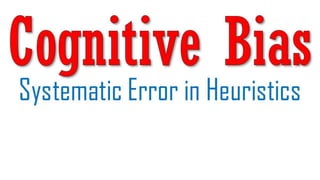


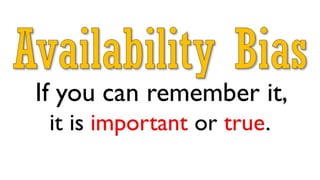
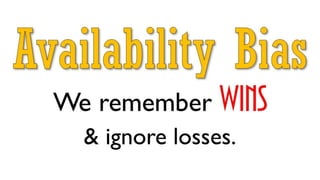
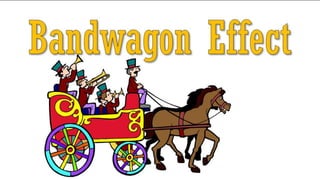









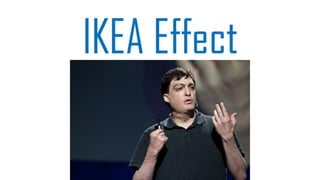



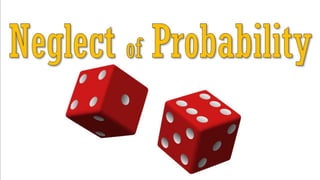



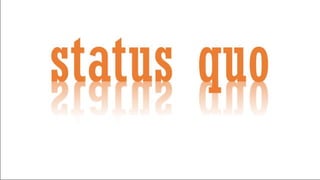
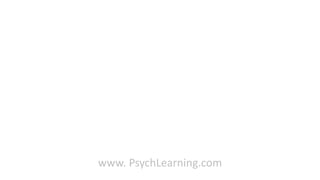
Ad
Recommended
Cognition
CognitionKen Tangen
Ã˝
The document discusses psychological heuristics and how perception, attention, and memory influence behavior and learning. It emphasizes the importance of using prior knowledge to interpret new information and suggests that learning should occur in multiple contexts. It references concepts from behaviorism and constructivism in the process of information processing.Expectations
ExpectationsKen Tangen
Ã˝
Dr. Ken Tangen gives a quick overview of the cognitive science of expectations, including heuristics, anchoring, satisficing and bounded rationality.Six Problem Solving Steps
Six Problem Solving StepsKen Tangen
Ã˝
This document outlines a 6-step process for problem solving: 1) Identify the current situation, 2) Determine the desired outcome, 3) Consider possible solutions for reaching the goal, 4) Evaluate whether potential solutions could work, 5) Implement a solution, 6) Re-examine the situation and repeat the process if needed.Conflict Types
Conflict TypesKen Tangen
Ã˝
Dollard and Miller's approach emphasizes making choices between preferences, suggesting that when faced with two liked options, one should choose the closest option, while for disliked options, one should remain neutral. As events like a wedding approach, confidence in choices may wane, highlighting the importance of labeling conflicts to mitigate indecision. The document stresses the psychological implications of choice and conflict management.Conflict
ConflictKen Tangen
Ã˝
The document discusses various theories related to how organisms respond to different stimulus intensities and the impact of hours of deprivation on response latency. It emphasizes the interplay between these factors in understanding behavior. The insights are drawn from psychlearning resources.Forgetting
ForgettingKen Tangen
Ã˝
The document discusses memory recall, specifically comparing the retention of faces to foreign languages and episodic memory. It notes that recall for faces declines relatively slowly, while it drops off quickly for foreign languages and nonsense syllables. Additionally, it mentions a steady decline in episodic memory, estimated at 5% per year.Observational Learning
Observational LearningKen Tangen
Ã˝
The document discusses various concepts related to learning and imitation, including instinctive behaviors, observational learning, and the impact of modeling on behavior. It emphasizes the role of self-efficacy in predicting the ability to deal with fear and how both children and animals imitate behaviors from their environments. The content references Bandura's theories of behaviorism and the significance of role models in shaping actions and gender roles.What Is A Schema
What Is A SchemaKen Tangen
Ã˝
This document discusses schemas, which are general knowledge structures that help individuals organize and interpret information. Schemas impact cognition in four main ways: selection, abstraction, interpretation, and integration. Schemas can both help recall by providing context but can also distort memory by leading individuals to remember details that were not actually present based on their expectations. The best way to minimize potential distortions is to provide context before presenting new information.Skills
SkillsKen Tangen
Ã˝
This document discusses developing expertise through focused practice on specific tasks with clear criteria for success, rather than assuming a generalized skill will emerge from practice alone. It emphasizes practicing skills until you can consistently perform them well and "stick the landing."Punishment
PunishmentKen Tangen
Ã˝
This document discusses different approaches to punishment, noting that punishment is often a reaction without thinking and that there are alternative approaches like mediation, negotiation, and problem solving. It suggests punishing proportionally and controlling one's reactions while considering changing perspectives.Concept or Mind Map of Social Cognitive Theory in Adult Education
Concept or Mind Map of Social Cognitive Theory in Adult EducationSafelink Internet Services
Ã˝
This document presents a concept map outlining Albert Bandura's social cognitive theory. The map shows that social cognitive theory posits that humans can learn through observation of modeled behaviors without reinforcement, through processes like attention, retention, production, and motivation. It depicts key concepts like self-efficacy, outcome expectations, goal setting, vicarious experiences, and reciprocal determinism.Behavioral Change In 33 Steps
Behavioral Change In 33 StepsKen Tangen
Ã˝
This document provides tips for promoting behavioral change through positive reinforcement techniques. Some key recommendations include breaking large behavior changes into smaller, more manageable parts; using specific, measurable goals rather than vague targets; gradually increasing expectations over time through a system of rewards; and varying cues, rewards and environments to maintain motivation. The overall approach emphasizes reinforcement of small improvements rather than focus on negatives or trying to change everything at once.Habits
HabitsKen Tangen
Ã˝
This document discusses learning through repetition and practice of behaviors, both conscious and unconscious. It mentions learning whole chains of responses through tiny stimulus-response connections and collections of movements, as well as practicing more to perform unconscious acts through dress rehearsals before going out again.Classical Conditioning
Classical ConditioningKen Tangen
Ã˝
Reflexes are automatic responses processed unconsciously in the central nervous system. Classical conditioning occurs when a previously neutral stimulus (the conditioned stimulus or CS) is paired with an unconditioned stimulus (UCS) that elicits an innate response, causing the CS to elicit a conditioned response over time through repeated associations formed in the brain between the CS and UCS. For optimal classical conditioning, there should be a short, half-second interval between the CS and UCS.Cognitive learning
Cognitive learning Amref International University
Ã˝
Cognitive learning theory focuses on how people think and process information. Key aspects include that learning is an active process where learners construct their own understanding, and that mental processes like observing and categorizing are important. Theorists discussed include Piaget, who identified stages of cognitive development, Bruner, who described modes of thinking, and Ausubel, who emphasized meaningful learning by relating new concepts to prior knowledge. The theory emphasizes giving learners opportunities to actively engage with and make sense of new information.Skinner's Atheoretical Operant Theory
Skinner's Atheoretical Operant TheoryKen Tangen
Ã˝
This 3 line poem discusses how success is defined by one's actions and efforts. It states that all boats rise due to operational factors rather than external forces alone. One's achievements are shaped by what they do each day through their work.20 Characteristics of Being an Expert
20 Characteristics of Being an ExpertKen Tangen
Ã˝
Dr. Ken Tangen gives a quick overview of the 20 characteristics that separate experts from novices.Cognitive learning theory
Cognitive learning theoryVerbena Wilburg
Ã˝
Cognitive learning theory emphasizes the role of internal mental processes in learning, highlighting that learners are active participants who process information through various cognitive strategies. Key psychologists such as Piaget, Bloom, Bruner, and Ausubel contributed to understanding cognitive development stages, meaningful learning, and the importance of organizing knowledge to facilitate learning. Teaching implications include using age-appropriate tasks, promoting meaningful engagement, and employing advance organizers to relate new material to existing knowledge.Cognitive theory ppt
Cognitive theory ppt05marisa
Ã˝
This document summarizes several cognitive learning theories:
- Allan Paivio's Dual Coding Theory which posits that people process information visually and verbally.
- Robert Gagne identified 5 categories of learning like verbal information, intellectual skills, and motor skills.
- Howard Gardner's Theory of Multiple Intelligences which identified 8 types of intelligence like linguistic and interpersonal.
- Benjamin Bloom concluded that every child has the ability to learn based on his research into the cognitive domain.
The cognitive theory views thinking and remembering as behaviors that can be analyzed to measure their effect on learning. It is interested in how people understand material.Piaget's Cognitive Development
Piaget's Cognitive DevelopmentARUL LAWRENCE
Ã˝
This document provides information about Jean Piaget's theory of cognitive development. It was prepared by A.S. Arul Lawrence, the principal of St. Joseph College of Education in India. The document defines key concepts in Piaget's theory such as schemas, assimilation, accommodation, equilibration, and Piaget's four stages of cognitive development - sensorimotor stage, preoperational stage, concrete operational stage, and formal operational stage.Jean Piaget's Theory of Cognitive Development
Jean Piaget's Theory of Cognitive DevelopmentKelly McGrail
Ã˝
Piaget's theory of cognitive development outlines 4 stages of development: sensorimotor (birth-2 years), preoperational (2-7 years), concrete operational (7-11 years), and formal operational (12 years and up). The stages are characterized by the development of object permanence, representational thought, logical reasoning, and abstract thought. Children with cognitive disabilities may not progress through all the stages. Down syndrome is provided as an example of a cognitive disability where individuals often do not complete all stages of Piaget's theory.Piaget’S Cognitive Development Theory
Piaget’S Cognitive Development Theorynewkirker
Ã˝
Piaget's theory of cognitive development consists of four stages:
1) Sensorimotor stage (birth to age 2) where children learn through senses and physical interaction.
2) Preoperational stage (ages 2-7) where children develop language and imagination but lack logical reasoning.
3) Concrete operational stage (ages 7-11) where children develop logical thinking skills and understand conservation.
4) Formal operational stage (ages 11 and up) where children develop abstract reasoning and can think hypothetically.
Piaget developed this theory by observing his own children and it focuses on how children construct an understanding of the world through experiences over time.Piaget cognitive development theory
Piaget cognitive development theoryراضیه rahmani
Ã˝
- Jean Piaget was a Swiss psychologist who developed a theory of cognitive development. He believed that children construct an understanding of the world through experiences interacting with objects and people.
- Piaget identified four stages of cognitive development: sensorimotor, preoperational, concrete operational, and formal operational. In the preoperational stage from ages 2-7, children begin to use language and think symbolically but still struggle with logical reasoning and conservation.
- Key concepts in Piaget's theory include schemas, assimilation, accommodation, and equilibration as children adjust their mental models to maintain equilibrium with new information from their environments.Cognitive Theory
Cognitive Theory jessbenavides25
Ã˝
Cognitive theory views thinking, decision making, and remembering as underlying behaviors. It focuses on how people think, understand, and acquire knowledge. Key cognitive theorists discussed include Paivio with his dual coding theory of verbal and nonverbal processing, Gagne with his learning hierarchies and instruction model, Gardner with his theory of multiple intelligences, and Bloom with his taxonomy of learning domains. Teachers can apply cognitive theory through expository teaching, meaningful learning connections, and dual coding with text and images. Students use memory and existing knowledge to organize and retain new information.Adler's Three Gates To The Unconscious Mind
Adler's Three Gates To The Unconscious MindKen Tangen
Ã˝
The document discusses Alfred Adler's theories on three gates to the unconscious: birth order, early memories, and dreams. It describes the personality traits associated with each birth order position, highlighting the characteristics of only children, firstborns, second-borns, and youngest children. The document also touches on the significance of early memories and dreams in shaping personality.Babies Explain Freud
Babies Explain FreudKen Tangen
Ã˝
The document outlines Freud's concepts of the id, ego, and superego, highlighting their roles in human psychology. It describes the id as the unconscious, pleasure-seeking component, the ego as the reality-oriented part that mediates between the id and the external world, and the superego as the moral conscience. Psychoanalysis is mentioned as a method for exploring these internal conflicts and understanding personality dynamics.How Do You Find Truth
How Do You Find TruthKen Tangen
Ã˝
The document outlines five distinct paths to truth: religion, wisdom, philosophy, science, and tangen's path. Each path approaches truth differently, with religion focusing on revelation, wisdom on insight, philosophy on logic, science on systematic observation, and tangen's path on luck. Collectively, they illustrate the diverse ways through which individuals may seek understanding and truth.Why Aren't You Paying Attention
Why Aren't You Paying AttentionKen Tangen
Ã˝
The document discusses the concept of the 'doorway phenomenon,' where people often forget thoughts when transitioning between rooms but recall them upon returning. It emphasizes the importance of location context cues in memory retrieval, highlighting how familiar places can trigger memories, like visiting a childhood home. Ultimately, it suggests that distractions often stem from focusing on different thoughts rather than a lack of attention.Thirty Five Learning Tips
Thirty Five Learning TipsKen Tangen
Ã˝
Thirty five principles for effective learning are presented, organized under categories like attention, encoding specificity, distributed practice, organizing information, teaching others, and incubation. The principles include chunking information, distributing practice over time, encoding information specifically, starting with the most important ideas, putting information in context, teaching concepts to others, and taking breaks to allow ideas to incubate.Metacognition & Encoding
Metacognition & EncodingKen Tangen
Ã˝
This document discusses several cognitive biases and phenomena including separating music into separate streams, the cocktail party effect, change blindness, and the invisible gorilla experiment. It also discusses the concepts of metacognition, distinctiveness including primary and secondary distinctiveness, emotional distinctiveness, and closure. The document appears to be about cognitive biases and phenomena from www.psychlearning.com.More Related Content
Viewers also liked (16)
Skills
SkillsKen Tangen
Ã˝
This document discusses developing expertise through focused practice on specific tasks with clear criteria for success, rather than assuming a generalized skill will emerge from practice alone. It emphasizes practicing skills until you can consistently perform them well and "stick the landing."Punishment
PunishmentKen Tangen
Ã˝
This document discusses different approaches to punishment, noting that punishment is often a reaction without thinking and that there are alternative approaches like mediation, negotiation, and problem solving. It suggests punishing proportionally and controlling one's reactions while considering changing perspectives.Concept or Mind Map of Social Cognitive Theory in Adult Education
Concept or Mind Map of Social Cognitive Theory in Adult EducationSafelink Internet Services
Ã˝
This document presents a concept map outlining Albert Bandura's social cognitive theory. The map shows that social cognitive theory posits that humans can learn through observation of modeled behaviors without reinforcement, through processes like attention, retention, production, and motivation. It depicts key concepts like self-efficacy, outcome expectations, goal setting, vicarious experiences, and reciprocal determinism.Behavioral Change In 33 Steps
Behavioral Change In 33 StepsKen Tangen
Ã˝
This document provides tips for promoting behavioral change through positive reinforcement techniques. Some key recommendations include breaking large behavior changes into smaller, more manageable parts; using specific, measurable goals rather than vague targets; gradually increasing expectations over time through a system of rewards; and varying cues, rewards and environments to maintain motivation. The overall approach emphasizes reinforcement of small improvements rather than focus on negatives or trying to change everything at once.Habits
HabitsKen Tangen
Ã˝
This document discusses learning through repetition and practice of behaviors, both conscious and unconscious. It mentions learning whole chains of responses through tiny stimulus-response connections and collections of movements, as well as practicing more to perform unconscious acts through dress rehearsals before going out again.Classical Conditioning
Classical ConditioningKen Tangen
Ã˝
Reflexes are automatic responses processed unconsciously in the central nervous system. Classical conditioning occurs when a previously neutral stimulus (the conditioned stimulus or CS) is paired with an unconditioned stimulus (UCS) that elicits an innate response, causing the CS to elicit a conditioned response over time through repeated associations formed in the brain between the CS and UCS. For optimal classical conditioning, there should be a short, half-second interval between the CS and UCS.Cognitive learning
Cognitive learning Amref International University
Ã˝
Cognitive learning theory focuses on how people think and process information. Key aspects include that learning is an active process where learners construct their own understanding, and that mental processes like observing and categorizing are important. Theorists discussed include Piaget, who identified stages of cognitive development, Bruner, who described modes of thinking, and Ausubel, who emphasized meaningful learning by relating new concepts to prior knowledge. The theory emphasizes giving learners opportunities to actively engage with and make sense of new information.Skinner's Atheoretical Operant Theory
Skinner's Atheoretical Operant TheoryKen Tangen
Ã˝
This 3 line poem discusses how success is defined by one's actions and efforts. It states that all boats rise due to operational factors rather than external forces alone. One's achievements are shaped by what they do each day through their work.20 Characteristics of Being an Expert
20 Characteristics of Being an ExpertKen Tangen
Ã˝
Dr. Ken Tangen gives a quick overview of the 20 characteristics that separate experts from novices.Cognitive learning theory
Cognitive learning theoryVerbena Wilburg
Ã˝
Cognitive learning theory emphasizes the role of internal mental processes in learning, highlighting that learners are active participants who process information through various cognitive strategies. Key psychologists such as Piaget, Bloom, Bruner, and Ausubel contributed to understanding cognitive development stages, meaningful learning, and the importance of organizing knowledge to facilitate learning. Teaching implications include using age-appropriate tasks, promoting meaningful engagement, and employing advance organizers to relate new material to existing knowledge.Cognitive theory ppt
Cognitive theory ppt05marisa
Ã˝
This document summarizes several cognitive learning theories:
- Allan Paivio's Dual Coding Theory which posits that people process information visually and verbally.
- Robert Gagne identified 5 categories of learning like verbal information, intellectual skills, and motor skills.
- Howard Gardner's Theory of Multiple Intelligences which identified 8 types of intelligence like linguistic and interpersonal.
- Benjamin Bloom concluded that every child has the ability to learn based on his research into the cognitive domain.
The cognitive theory views thinking and remembering as behaviors that can be analyzed to measure their effect on learning. It is interested in how people understand material.Piaget's Cognitive Development
Piaget's Cognitive DevelopmentARUL LAWRENCE
Ã˝
This document provides information about Jean Piaget's theory of cognitive development. It was prepared by A.S. Arul Lawrence, the principal of St. Joseph College of Education in India. The document defines key concepts in Piaget's theory such as schemas, assimilation, accommodation, equilibration, and Piaget's four stages of cognitive development - sensorimotor stage, preoperational stage, concrete operational stage, and formal operational stage.Jean Piaget's Theory of Cognitive Development
Jean Piaget's Theory of Cognitive DevelopmentKelly McGrail
Ã˝
Piaget's theory of cognitive development outlines 4 stages of development: sensorimotor (birth-2 years), preoperational (2-7 years), concrete operational (7-11 years), and formal operational (12 years and up). The stages are characterized by the development of object permanence, representational thought, logical reasoning, and abstract thought. Children with cognitive disabilities may not progress through all the stages. Down syndrome is provided as an example of a cognitive disability where individuals often do not complete all stages of Piaget's theory.Piaget’S Cognitive Development Theory
Piaget’S Cognitive Development Theorynewkirker
Ã˝
Piaget's theory of cognitive development consists of four stages:
1) Sensorimotor stage (birth to age 2) where children learn through senses and physical interaction.
2) Preoperational stage (ages 2-7) where children develop language and imagination but lack logical reasoning.
3) Concrete operational stage (ages 7-11) where children develop logical thinking skills and understand conservation.
4) Formal operational stage (ages 11 and up) where children develop abstract reasoning and can think hypothetically.
Piaget developed this theory by observing his own children and it focuses on how children construct an understanding of the world through experiences over time.Piaget cognitive development theory
Piaget cognitive development theoryراضیه rahmani
Ã˝
- Jean Piaget was a Swiss psychologist who developed a theory of cognitive development. He believed that children construct an understanding of the world through experiences interacting with objects and people.
- Piaget identified four stages of cognitive development: sensorimotor, preoperational, concrete operational, and formal operational. In the preoperational stage from ages 2-7, children begin to use language and think symbolically but still struggle with logical reasoning and conservation.
- Key concepts in Piaget's theory include schemas, assimilation, accommodation, and equilibration as children adjust their mental models to maintain equilibrium with new information from their environments.Cognitive Theory
Cognitive Theory jessbenavides25
Ã˝
Cognitive theory views thinking, decision making, and remembering as underlying behaviors. It focuses on how people think, understand, and acquire knowledge. Key cognitive theorists discussed include Paivio with his dual coding theory of verbal and nonverbal processing, Gagne with his learning hierarchies and instruction model, Gardner with his theory of multiple intelligences, and Bloom with his taxonomy of learning domains. Teachers can apply cognitive theory through expository teaching, meaningful learning connections, and dual coding with text and images. Students use memory and existing knowledge to organize and retain new information.More from Ken Tangen (15)
Adler's Three Gates To The Unconscious Mind
Adler's Three Gates To The Unconscious MindKen Tangen
Ã˝
The document discusses Alfred Adler's theories on three gates to the unconscious: birth order, early memories, and dreams. It describes the personality traits associated with each birth order position, highlighting the characteristics of only children, firstborns, second-borns, and youngest children. The document also touches on the significance of early memories and dreams in shaping personality.Babies Explain Freud
Babies Explain FreudKen Tangen
Ã˝
The document outlines Freud's concepts of the id, ego, and superego, highlighting their roles in human psychology. It describes the id as the unconscious, pleasure-seeking component, the ego as the reality-oriented part that mediates between the id and the external world, and the superego as the moral conscience. Psychoanalysis is mentioned as a method for exploring these internal conflicts and understanding personality dynamics.How Do You Find Truth
How Do You Find TruthKen Tangen
Ã˝
The document outlines five distinct paths to truth: religion, wisdom, philosophy, science, and tangen's path. Each path approaches truth differently, with religion focusing on revelation, wisdom on insight, philosophy on logic, science on systematic observation, and tangen's path on luck. Collectively, they illustrate the diverse ways through which individuals may seek understanding and truth.Why Aren't You Paying Attention
Why Aren't You Paying AttentionKen Tangen
Ã˝
The document discusses the concept of the 'doorway phenomenon,' where people often forget thoughts when transitioning between rooms but recall them upon returning. It emphasizes the importance of location context cues in memory retrieval, highlighting how familiar places can trigger memories, like visiting a childhood home. Ultimately, it suggests that distractions often stem from focusing on different thoughts rather than a lack of attention.Thirty Five Learning Tips
Thirty Five Learning TipsKen Tangen
Ã˝
Thirty five principles for effective learning are presented, organized under categories like attention, encoding specificity, distributed practice, organizing information, teaching others, and incubation. The principles include chunking information, distributing practice over time, encoding information specifically, starting with the most important ideas, putting information in context, teaching concepts to others, and taking breaks to allow ideas to incubate.Metacognition & Encoding
Metacognition & EncodingKen Tangen
Ã˝
This document discusses several cognitive biases and phenomena including separating music into separate streams, the cocktail party effect, change blindness, and the invisible gorilla experiment. It also discusses the concepts of metacognition, distinctiveness including primary and secondary distinctiveness, emotional distinctiveness, and closure. The document appears to be about cognitive biases and phenomena from www.psychlearning.com.Technical Mnemonics
Technical MnemonicsKen Tangen
Ã˝
The document discusses the method of loci, a memorization technique that involves visualizing a familiar journey or location to enhance memory recall. It also mentions various memory aids such as peg systems, photos, and physical reminders, including alarms and timers. The source of the information is indicated to be psychlearning.com.Naive Mnemonics
Naive MnemonicsKen Tangen
Ã˝
The document discusses the concept of backward chaining in training, emphasizing that color is not beneficial for memory retention. It mentions the use of interactive methods but notes the lack of vividness. Additionally, it references radar running times for various aircraft models.Context & Learning
Context & LearningKen Tangen
Ã˝
The document discusses how context influences memory and performance, emphasizing the importance of studying in multiple settings to enhance retention. It highlights the encoding specificity principle, suggesting to study where one intends to perform. Additionally, it touches on biases in memory related to emotional and physical states.Working Memory
Working MemoryKen Tangen
Ã˝
The document discusses a system that aids animals in memory recall and assists children in game rule retention. It consists of four parts that assess and prioritize incoming information while managing various cognitive units. Additionally, it highlights the functions of working memory, including the processing of sounds, words, music, and images.Paired Assoicates
Paired AssoicatesKen Tangen
Ã˝
The document discusses the use of sentence completion and paired associates as methods to measure intelligence and memory. It emphasizes the significance of word associations in memory retention and its applications in advertisements and educational settings. The concepts are rooted in Ebbinghaus’ and Calkins' research on memory and association.Learn slides 01 lists ebb
Learn slides 01 lists ebbKen Tangen
Ã˝
Hermann Ebbinghaus (1850-1909) was a German psychologist known for his research on memory. He studied the serial position effect and developed the forgetting curve through experiments where he learned nonsense syllables and tracked his own retention of the material over time. His work showed that memory retention decreases rapidly over time and that distributing practice sessions is more effective for learning than mass practice.Before Ebbinghaus
Before EbbinghausKen Tangen
Ã˝
The document summarizes key ideas in the study of psychology from Aristotle to the early 20th century. It covers Aristotle's laws of association, Descartes' distinction between involuntary and voluntary behavior, Locke's view of a blank slate shaped by education, Darwin's theory of evolution by natural selection, Galton's view of intelligence as a single entity subject to artificial selection through eugenics, criticisms of using anecdotes rather than scientific studies in the work of Romanes on animal intelligence, and the debunking of Clever Hans the horse's apparent mathematical abilities by showing he read subtle body language cues instead.Tangen's Top Ten Tips for Learning
Tangen's Top Ten Tips for LearningKen Tangen
Ã˝
People are not good at multitasking and should avoid overloading their attention. It is better to break large tasks into smaller chunks that can be completed one at a time. When learning new information, it is easier to store and recall if the material is learned in chunks and through practice over time rather than all at once.Schizophrenia
SchizophreniaKen Tangen
Ã˝
The document discusses negative symptoms of schizophrenia, which include loss of facial expression, speech, pleasure, and hygiene. Negative symptoms also involve thinking deficits and can be confused with other disorders. They are lonely, scary experiences that bother patients the most. Negative symptoms make it difficult to express feelings or live independently due to problems with social interaction. Some cases of schizophrenia only involve negative symptoms, formerly known as "simple schizophrenia".Ad
Recently uploaded (20)
How to use search fetch method in Odoo 18
How to use search fetch method in Odoo 18Celine George
Ã˝
The search_fetch is a powerful ORM method used in Odoo for some specific addons to combine the functionality of search and read for more efficient data fetching. It might be used to search for records and fetch specific fields in a single call. It stores the result in the cache memory.Paper 108 | Thoreau’s Influence on Gandhi: The Evolution of Civil Disobedience
Paper 108 | Thoreau’s Influence on Gandhi: The Evolution of Civil DisobedienceRajdeep Bavaliya
Ã˝
Dive into the powerful journey from Thoreau’s 19th‑century essay to Gandhi’s mass movement, and discover how one man’s moral stand became the backbone of nonviolent resistance worldwide. Learn how conscience met strategy to spark revolutions, and why their legacy still inspires today’s social justice warriors. Uncover the evolution of civil disobedience. Don’t forget to like, share, and follow for more deep dives into the ideas that changed the world.
M.A. Sem - 2 | Presentation
Presentation Season - 2
Paper - 108: The American Literature
Submitted Date: April 2, 2025
Paper Name: The American Literature
Topic: Thoreau’s Influence on Gandhi: The Evolution of Civil Disobedience
[Please copy the link and paste it into any web browser to access the content.]
Video Link: https://youtu.be/HXeq6utg7iQ
For a more in-depth discussion of this presentation, please visit the full blog post at the following link: https://rajdeepbavaliya2.blogspot.com/2025/04/thoreau-s-influence-on-gandhi-the-evolution-of-civil-disobedience.html
Please visit this blog to explore additional presentations from this season:
Hashtags:
#CivilDisobedience #ThoreauToGandhi #NonviolentResistance #Satyagraha #Transcendentalism #SocialJustice #HistoryUncovered #GandhiLegacy #ThoreauInfluence #PeacefulProtest
Keyword Tags:
civil disobedience, Thoreau, Gandhi, Satyagraha, nonviolent protest, transcendentalism, moral resistance, Gandhi Thoreau connection, social change, political philosophyA Visual Introduction to the Prophet Jeremiah
A Visual Introduction to the Prophet JeremiahSteve Thomason
Ã˝
These images will give you a visual guide to both the context and the flow of the story of the prophet Jeremiah. Feel free to use these in your study, preaching, and teaching.Birnagar High School Platinum Jubilee Quiz.pptx
Birnagar High School Platinum Jubilee Quiz.pptxSourav Kr Podder
Ã˝
Birnagar High School Platinum Jubilee Celebration QuizGreat Governors' Send-Off Quiz 2025 Prelims IIT KGP
Great Governors' Send-Off Quiz 2025 Prelims IIT KGPIIT Kharagpur Quiz Club
Ã˝
Prelims of the Great Governors' Send-Off Quiz 2025 hosted by the outgoing governors.
QMs: Aarushi, Aatir, Aditya, ArnavLDMMIA Shop & Student News Summer Solstice 25
LDMMIA Shop & Student News Summer Solstice 25LDM & Mia eStudios
Ã˝
6/18/25
Shop, Upcoming: Final Notes to Review as we Close Level One. Make sure to review the orientation and videos as well. There’s more to come and material to cover in Levels 2-3. The content will be a combination of Reiki and Yoga. Also energy topics of our spiritual collective.
Thanks again all future Practitioner Level Students. Our Levels so far are: Guest, Grad, and Practitioner. We have had over 5k Spring Views.
https://ldm-mia.creator-spring.comK12 Tableau User Group virtual event June 18, 2025
K12 Tableau User Group virtual event June 18, 2025dogden2
Ã˝
National K12 Tableau User Group: June 2025 meeting slidesTanja Vujicic - PISA for Schools contact Info
Tanja Vujicic - PISA for Schools contact InfoEduSkills OECD
Ã˝
Tanja Vujicic, Senior Analyst and PISA for School’s Project Manager at the OECD spoke at the OECD webinar 'Turning insights into impact: What do early case studies reveal about the power of PISA for Schools?' on 20 June 2025
PISA for Schools is an OECD assessment that evaluates 15-year-old performance on reading, mathematics, and science. It also gathers insights into students’ learning environment, engagement and well-being, offering schools valuable data that help them benchmark performance internationally and improve education outcomes. A central ambition, and ongoing challenge, has been translating these insights into meaningful actions that drives lasting school improvement. Paper 107 | From Watchdog to Lapdog: Ishiguro’s Fiction and the Rise of “Godi...
Paper 107 | From Watchdog to Lapdog: Ishiguro’s Fiction and the Rise of “Godi...Rajdeep Bavaliya
Ã˝
Dive into a captivating analysis where Kazuo Ishiguro’s nuanced fiction meets the stark realities of post‑2014 Indian journalism. Uncover how “Godi Media” turned from watchdog to lapdog, echoing the moral compromises of Ishiguro’s protagonists. We’ll draw parallels between restrained narrative silences and sensationalist headlines—are our media heroes or traitors? Don’t forget to follow for more deep dives!
M.A. Sem - 2 | Presentation
Presentation Season - 2
Paper - 107: The Twentieth Century Literature: From World War II to the End of the Century
Submitted Date: April 4, 2025
Paper Name: The Twentieth Century Literature: From World War II to the End of the Century
Topic: From Watchdog to Lapdog: Ishiguro’s Fiction and the Rise of “Godi Media” in Post-2014 Indian Journalism
[Please copy the link and paste it into any web browser to access the content.]
Video Link: https://youtu.be/kIEqwzhHJ54
For a more in-depth discussion of this presentation, please visit the full blog post at the following link: https://rajdeepbavaliya2.blogspot.com/2025/04/from-watchdog-to-lapdog-ishiguro-s-fiction-and-the-rise-of-godi-media-in-post-2014-indian-journalism.html
Please visit this blog to explore additional presentations from this season:
Hashtags:
#GodiMedia #Ishiguro #MediaEthics #WatchdogVsLapdog #IndianJournalism #PressFreedom #LiteraryCritique #AnArtistOfTheFloatingWorld #MediaCapture #KazuoIshiguro
Keyword Tags:
Godi Media, Ishiguro fiction, post-2014 Indian journalism, media capture, Kazuo Ishiguro analysis, watchdog to lapdog, press freedom India, media ethics, literature and media, An Artist of the Floating WorldIIT KGP Quiz Week 2024 Sports Quiz (Prelims + Finals)
IIT KGP Quiz Week 2024 Sports Quiz (Prelims + Finals)IIT Kharagpur Quiz Club
Ã˝
The document outlines the format for the Sports Quiz at Quiz Week 2024, covering various sports & games and requiring participants to Answer without external sources. It includes specific details about question types, scoring, and examples of quiz questions. The document emphasizes fair play and enjoyment of the quiz experience.University of Ghana Cracks Down on Misconduct: Over 100 Students Sanctioned
University of Ghana Cracks Down on Misconduct: Over 100 Students SanctionedKweku Zurek
Ã˝
University of Ghana Cracks Down on Misconduct: Over 100 Students Sanctioned
2025 June Year 9 Presentation: Subject selection.pptx
2025 June Year 9 Presentation: Subject selection.pptxmansk2
Ã˝
2025 June Year 9 Presentation: Subject selectionECONOMICS, DISASTER MANAGEMENT, ROAD SAFETY - STUDY MATERIAL [10TH]
ECONOMICS, DISASTER MANAGEMENT, ROAD SAFETY - STUDY MATERIAL [10TH]SHERAZ AHMAD LONE
Ã˝
This study material for Class 10th covers the core subjects of Economics, Disaster Management, and Road Safety Education, developed strictly in line with the JKBOSE textbook. It presents the content in a simplified, structured, and student-friendly format, ensuring clarity in concepts. The material includes reframed explanations, flowcharts, infographics, and key point summaries to support better understanding and retention. Designed for classroom teaching and exam preparation, it aims to enhance comprehension, critical thinking, and practical awareness among students.Vitamin and Nutritional Deficiencies.pptx
Vitamin and Nutritional Deficiencies.pptxVishal Chanalia
Ã˝
Vitamin and nutritional deficiency occurs when the body does not receive enough essential nutrients, such as vitamins and minerals, needed for proper functioning. This can lead to various health problems, including weakened immunity, stunted growth, fatigue, poor wound healing, cognitive issues, and increased susceptibility to infections and diseases. Long-term deficiencies can cause serious and sometimes irreversible health complications.List View Components in Odoo 18 - Odoo ∫›∫›fl£s
List View Components in Odoo 18 - Odoo ∫›∫›fl£sCeline George
Ã˝
In Odoo, there are many types of views possible like List view, Kanban view, Calendar view, Pivot view, Search view, etc.
The major change that introduced in the Odoo 18 technical part in creating views is the tag <tree> got replaced with the <list> for creating list views. F-BLOCK ELEMENTS POWER POINT PRESENTATIONS
F-BLOCK ELEMENTS POWER POINT PRESENTATIONSmprpgcwa2024
Ã˝
F-block elements are a group of elements in the periodic table that have partially filled f-orbitals. They are also known as inner transition elements. F-block elements are divided into two series:
1.Lanthanides (La- Lu) These elements are also known as rare earth elements.
2.Actinides (Ac- Lr): These elements are radioactive and have complex electronic configurations.
F-block elements exhibit multiple oxidation states due to the availability of f-orbitals.
2. Many f-block compounds are colored due to f-f transitions.
3. F-block elements often exhibit paramagnetic or ferromagnetic behavior.4. Actinides are radioactive.
F-block elements are used as catalysts in various industrial processes.
Actinides are used in nuclear reactors and nuclear medicine.
F-block elements are used in lasers and phosphors due to their luminescent properties.
F-block elements have unique electronic and magnetic properties.Code Profiling in Odoo 18 - Odoo 18 ∫›∫›fl£s
Code Profiling in Odoo 18 - Odoo 18 ∫›∫›fl£sCeline George
Ã˝
Profiling in Odoo identifies slow code and resource-heavy processes, ensuring better system performance. Odoo code profiling detects bottlenecks in custom modules, making it easier to improve speed and scalability.Sustainable Innovation with Immersive Learning
Sustainable Innovation with Immersive LearningLeonel Morgado
Ã˝
Prof. Leonel and Prof. Dennis approached educational uses, practices, and strategies of using immersion as a lens to interpret, design, and planning educational activities in a sustainable way. Rather than one-off gimmicks, the intent is to enable instructors (and institutions) to be able to include them in their regular activities, including the ability to evaluate and redesign them.
Immersion as a phenomenon enables interpreting pedagogical activities in a learning-agnostic way: you take a stance on the learning theory to follow, and leverage immersion to envision and guide your practice.Paper 107 | From Watchdog to Lapdog: Ishiguro’s Fiction and the Rise of “Godi...
Paper 107 | From Watchdog to Lapdog: Ishiguro’s Fiction and the Rise of “Godi...Rajdeep Bavaliya
Ã˝
Ad